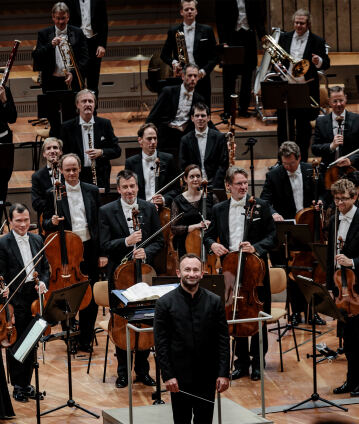Kirill Petrenko conducts Strauss, Shostakovich and Norman

Chief conductor Kirill Petrenko presents two works that reflect the end of the Second World War in very different ways. On the one hand Richard Strauss’s Metamorphosen: a web of sound for 23 solo strings that with warmth and transparency mourns a devastated world. In the case of Shostakovich’s Ninth Symphony, the Soviet rulers hoped for a victory symphony – but received a bright, ironic work that refuses to rejoice. We also hear Andrew Norman’s Sabina, a sound painting full of iridescent reflections of light.
For several years, Richard Strauss only wrote “exercises for the wrist” for himself; he had long since declared his actual work complete. After the destruction of the Munich National Theatre and after all musical activity had been stopped by order of Goebbels, Strauss’s life was in ruins. He expressed his grief with his Metamorphosen. At the end, the funeral march from Beethoven’s “Eroica” is heard in the basses, with the composer adding the words “In memoriam!” underneath. What or who exactly he meant by this remains ambiguous.
Dmitri Shostakovich was saddled with the expectations of a giant socialist state that wanted to hear a victory symphony with choir and soloists after winning the war. But instead of the jubilant piece he himself had promised, Shostakovich delivered a completely unheroic, modestly scored Ninth Symphony. Haydn and Mozart could not have composed such a sonata movement more classically. However, the themes go beyond traditional metre structures, forcing extended bars and causing the music to falter. In the slow movement, every attempted upturn in the clarinet falters; the last long note of the piccolo fades “morendo”, dying away. In the largo, the bassoon complains in the face of domineering brass; the exaggerated cheerfulness in the finale has a cautious effect. This was not how they had imagined the joy of peace. Was Shostakovich’s refusal to sing the hymn merely inability or perhaps the coded protest of a dissident? Stalin did not know what to make of it, and that was fatal. Soon afterwards, the composer had to pay bitterly for this, being ostracised by Soviet cultural policy.
Andrew Norman has composed for the Berliner Philharmoniker Foundation on several occasions. Sabina was originally written for string trio and is the last movement of The Companion Guide to Rome, a cycle consisting of nine miniatures inspired by Roman churches. The composer had visited “the ancient church of Santa Sabina on the Aventine in Rome” at daybreak and observed at sunrise how “the light shines through the elaborately framed windows” and “luminous patterns emerge on all the marble and mosaic surfaces of the church”. In Sabina, the mixing ratio of sound and noise is constantly rebalanced and the changing incidence of light is followed.
© 2020 Berlin Phil Media GmbH
Related interviews
Artists
Our recommendations
- Kirill Petrenko conducts Beethoven’s Ninth Symphony at the Brandenburg Gate
- Concert with Kirill Petrenko and Daniil Trifonov
- 2020 Europakonzert from the Philharmonie Berlin with Kirill Petrenko
- Kirill Petrenko conducts Beethoven and Elgar
- Benefit concert “Together for humanity”
- Kirill Petrenko conducts Tchaikovsky’s “Queen of Spades” in Baden-Baden